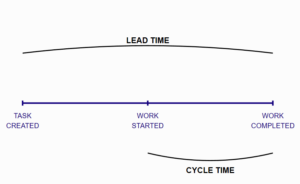Table of Contents
1 Understanding Cycle Time: A Comprehensive Guide
1.1 Introduction
In the realms of manufacturing, software development, and project management, the term “cycle time” holds significant weight. It serves as a critical metric that helps organizations gauge their efficiency, productivity, and overall performance. Cycle time refers to the total time taken to complete a specific process, from the initiation of a task to its completion. It encompasses various stages, including planning, execution, and delivery, making it a pivotal metric for continuous improvement initiatives.
This article aims to provide an in-depth understanding of cycle time, exploring its definition, implications, and applications across various industries. We will delve into specific aspects such as the importance of cycle time, methods of measurement, common misconceptions, and practical applications in real-world scenarios. By the end, readers will have a comprehensive grasp of cycle time and its relevance in today’s fast-paced environments.
1.2 Defining Cycle Time
Cycle time can be defined as the total elapsed time from the beginning to the end of a process. In manufacturing, it includes the time taken to complete a product from the moment raw materials are received until the finished product is shipped. in software development, cycle time often refers to the time taken from when a feature is requested until it is deployed.
1. Processing Time: This is the time when actual work is being performed on the task. It can vary significantly depending on the complexity of the task and the resources available.
2. Queue Time: This represents the waiting period before a task begins processing. In manufacturing, this could be the time a product spends waiting for the next machine to become available.
3. Setup Time: This includes the time required to prepare for a task or process, such as configuring machines or systems before production starts.
4. Idle Time: This is the period when no action is taking place due to various factors, such as equipment failure or lack of materials.
The formula for cycle time can be expressed as:

This formula highlights the multifaceted nature of cycle time and its dependence on various factors.
1.3 Importance of Cycle Time
Cycle time is a vital indicator of operational efficiency. Reducing cycle time can lead to increased output and lower production costs. For instance, a manufacturing plant that can cut its cycle time from 10 days to 7 days can produce more units in the same timeframe, thus improving profitability.
In today’s market, customers expect quick turnaround times. A shorter cycle time can lead to faster delivery of products and services, significantly enhancing customer satisfaction. For example, companies like Amazon have revolutionized the e-commerce landscape by minimizing cycle times, allowing them to offer same-day or next-day delivery.
Cycle time metrics are integral to continuous improvement methodologies such as Lean and Six Sigma. By analyzing cycle times, organizations can identify bottlenecks and inefficiencies, leading to targeted improvements and streamlined processes.
Understanding cycle time helps organizations allocate resources more effectively. By knowing how long a process typically takes, managers can better plan staffing, equipment usage, and inventory levels.
1.4 Measuring Cycle Time
Accurate measurement of cycle time is crucial for effective analysis and improvement. Here are some common methods used to measure cycle time in different contexts:
Time studies involve observing and recording the time taken to complete specific tasks. This method is particularly useful in manufacturing settings where processes are repetitive.
- Select a representative sample of tasks.
- Use a stopwatch or specialized software to record the time taken for each task.
- Calculate the average cycle time based on the collected data.
Process mapping involves visually representing the steps involved in a process. This can help identify bottlenecks and areas for improvement.
- Create a flowchart outlining each step in the process.
- Use symbols to denote different stages, such as processing, waiting, and decision points.
- Analyze the map to determine the cycle time for each segment.
Many organizations leverage software tools to track and measure cycle time automatically. These tools can provide real-time data and analytics, making it easier to monitor performance.
- JIRA: Commonly used in software development, JIRA tracks cycle times for individual tasks and sprints.
- Trello: Offers visual boards to manage tasks and can be used to measure cycle time for projects.
- Manufacturing Execution Systems (MES): These systems provide comprehensive data on cycle times across manufacturing processes.
1.5 Common Misconceptions About Cycle Time
Despite its importance, several misconceptions about cycle time persist. Addressing these can enhance understanding and application.
While closely related, cycle time and lead time are not the same. Cycle time measures the time taken to complete a process, whereas lead time encompasses the entire time from order placement to delivery. Understanding this distinction is crucial for effective planning and customer communication.
While shorter cycle times can enhance efficiency, they may also lead to quality issues if not managed correctly. Organizations must balance speed with quality to avoid defects and rework, which can ultimately increase cycle time.
Cycle time can fluctuate based on various factors such as demand, resource availability, and process changes. Organizations should regularly review and adjust their cycle time metrics to reflect current conditions.
1.6 Practical Applications in Real-World Scenarios
Cycle time metrics are applicable across various industries, each with unique challenges and opportunities. Here are some real-world applications:
In manufacturing, cycle time is critical for optimizing production lines. For example, Toyota employs Just-In-Time (JIT) manufacturing principles, which focus on reducing cycle time to minimize inventory holding costs and enhance responsiveness to customer demands.
In agile software development, cycle time, often referred to as “lead time for changes,” is a crucial metric that measures the time it takes for a team to move a work item from the “in progress” state to the “done” state. This metric is essential because it directly impacts the team’s ability to deliver value to customers quickly and respond to market changes efficiently.
Teams strive to minimize cycle time for several reasons:
- Faster Time-to-Market: Shorter cycle times mean that new features, bug fixes, and improvements can be released more quickly, giving companies a competitive edge.
- Increased Customer Satisfaction: Rapid delivery of features and fixes leads to higher customer satisfaction as their needs are met more promptly.
- Reduced Risk: Shorter cycles mean smaller batches of work, which are easier to test and less likely to introduce complex bugs.
- Improved Feedback Loop: Faster delivery allows teams to gather user feedback more quickly, enabling them to iterate and improve their product more effectively.
- Enhanced Team Morale: Seeing the results of their work more frequently can boost team motivation and satisfaction.
Here are some real-world scenarios that demonstrate the importance of cycle time:
- E-commerce Platform Updates: Imagine an e-commerce company preparing for a major holiday sale. With a short cycle time, they can rapidly implement and test new features like personalized recommendations or streamlined checkout processes. This agility allows them to optimize the user experience and potentially increase sales during critical periods.
- Fintech App Security Patches: In the financial technology sector, security is paramount. If a vulnerability is discovered, a team with a short cycle time can develop, test, and deploy a patch much faster than a team with a longer cycle time. This quick response can prevent potential security breaches and maintain customer trust.
- Social Media Feature Rollout: Social media platforms often compete by introducing new features. A platform with a shorter cycle time can develop and release new engagement features (like story reactions or augmented reality filters) more quickly, potentially capturing market share from slower-moving competitors.
- Video Streaming Service Optimization: Streaming services constantly work on optimizing their video delivery algorithms. A team with a short cycle time can make frequent, small adjustments to their recommendation engine or buffering algorithms, continuously improving the user experience based on real-time data.
- Mobile Game Updates: In the highly competitive mobile gaming market, frequent updates are crucial for retaining players. A game development team with a short cycle time can rapidly address player feedback, fix bugs, and introduce new content, keeping the game fresh and engaging.
- Healthcare Software Improvements: In healthcare software, such as electronic health record systems, quick updates can be critical. A short cycle time allows for rapid implementation of new medical coding standards or integration of new treatment protocols, ensuring healthcare providers always have up-to-date tools.
To achieve shorter cycle times, teams often employ various DevOps practices:
- Continuous Integration (CI): Automatically building and testing code changes as they’re committed.
- Continuous Delivery (CD): Automating the release process so that deployments can happen at any time with minimal human intervention.
- Automated Testing: Implementing comprehensive automated test suites to catch issues early and reduce manual testing time.
- Infrastructure as Code: Managing and provisioning infrastructure through code, allowing for rapid and consistent environment setup.
- Microservices Architecture: Breaking down applications into smaller, independently deployable services to allow for more frequent, targeted updates.
In supply chain management, cycle time affects inventory turnover and customer fulfillment. Companies like Dell have optimized their supply chains to reduce cycle times, allowing them to deliver customized products quickly.
1.7 Best Practices for Optimizing Cycle Time
To maximize the benefits of cycle time analysis, organizations should consider the following best practices:
Regularly monitor cycle times to identify trends and fluctuations. Use software tools to automate data collection and analysis for real-time insights.
Involve employees in cycle time improvement initiatives. Their insights can help identify bottlenecks and suggest practical solutions.
Utilize technology to streamline processes and reduce cycle times. Automation, data analytics, and process optimization tools can significantly enhance efficiency.
Ensure that efforts to reduce cycle time do not compromise quality. Implement quality control measures to maintain standards while optimizing processes.
Establish clear, measurable goals for cycle time reduction. Use these goals to guide improvement initiatives and track progress.
1.8 Conclusion
Cycle time is a multifaceted metric that plays a crucial role in assessing and enhancing operational efficiency across various industries. By understanding its components, implications, and measurement methods, organizations can leverage cycle time to drive continuous improvement, enhance customer satisfaction, and optimize resource allocation.
As industries evolve and technology advances, the importance of cycle time will only increase. Future developments may include more sophisticated analytical tools and techniques for real-time monitoring and optimization of cycle time. Organizations that prioritize cycle time management will be better positioned to thrive in an increasingly competitive landscape.
In summary, cycle time is not merely a number; it is a vital indicator of an organization‘s health and efficiency. By embracing best practices and fostering a culture of continuous improvement, businesses can unlock the full potential of cycle time management.
Latest Articles




